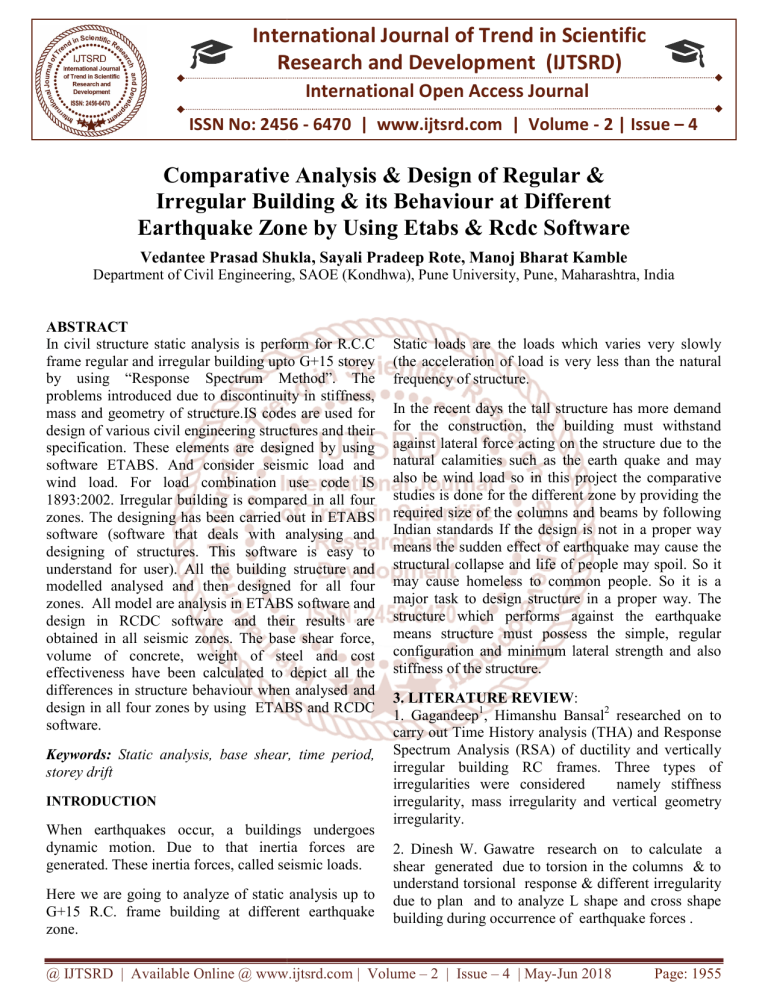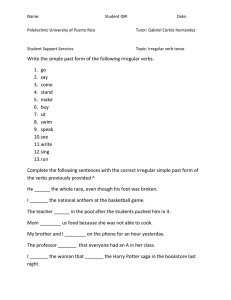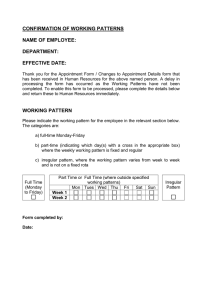
International Journal of Trend in Scientific
Research and Development (IJTSRD)
International Open Access Journal
ISSN No: 2456 - 6470 | www.ijtsrd.com | Volume - 2 | Issue – 4
Comparative Analysis & Design ooff Regular &
Irregular
egular Building & its Behaviour
ur at Different
Earthquake Zone by Using Etabs & Rcdc Software
Vedantee Prasad Shukla
Shukla, Sayali Pradeep Rote,, Manoj Bharat Kamble
Department of Civil Engineering, SAOE (Kondhwa), Pune University,, Pune, Maharashtra, India
ABSTRACT
In civil structure static analysis is perform for R.C.C
frame regular and irregular building upto G+15 storey
by using “Response Spectrum Method”. The
problems introduced due to discontinuity in stiffness,
mass and geometry of structure.IS codes are used for
design of various civil engineering structures and their
specification. These elements are designed by using
software ETABS. And consider seismic load and
wind load. For load combination use code IS
1893:2002. Irregular building is compared in all four
zones. The designing has been carried out in ETABS
software (software that deals with analysing and
designing of structures. This software is easy to
understand for user). All the building structure and
modelled analysed and then designed for all four
zones. All model are analysis in ETABS so
software and
design in RCDC software and their results are
obtained in all seismic zones. The base shear force,
volume of concrete, weight of steel and cost
effectiveness have been calculated to depict all the
differences in structure behaviour when analysed and
design in all four zones by using ETABS and RCDC
software.
Keywords: Static analysis, base shear, time period,
storey drift
INTRODUCTION
When earthquakes occur, a buildings undergoes
dynamic motion. Due to that inertia forces are
generated. These inertia forces, called seismic loads.
Here we are going to analyze of static analysis up to
G+15 R.C. frame building at different earthquake
zone.
Static loads are the loads which varies very slowly
(the acceleration of load is very less than the natural
frequency of structure.
In the recent days the tall structure has more demand
for the construction, the building must withstand
against lateral force acting on the structure due to the
natural calamities such as the earth quake and may
also be wind load so in this project the comparative
studies is done for the different zone by providing the
required size of the columns and beams by following
Indian standards If the design is not in a proper way
means the sudden effect of earthquake may cause the
structural collapse and life of people may spoil. So it
may cause homeless to common people. So it is a
major task to design structure in a proper way. The
structure which performs against the earthquake
means structure must possess the simple, regular
configuration and minimum lateral strength and also
stiffness of the structure.
3. LITERATURE REVIEW:
1. Gagandeep1, Himanshu Bansal2 researched on to
carry out Time History analysis (THA) and Response
Spectrum Analysis (RSA) of ductility and vertically
irregular building
ing RC frames. Three types of
irregularities were considered
namely stiffness
irregularity, mass irregularity and vertical geometry
irregularity.
2. Dinesh W. Gawatre research on to calculate a
shear generated due to torsion in the columns & to
understand torsional response & different irregularity
due to plan and to analyze L shape and cross shape
building during occurrence of earthquake forces .
@ IJTSRD | Available Online @ www.ijtsrd.com | Volume – 2 | Issue – 4 | May-Jun
Jun 2018
Page: 1955
International Journal of Trend in Scientific Research and Development (IJTSRD) ISSN: 2456-6470
3. Priyabrata1 Arunava2 research on earthquake
occurrence & suggest preventive measures to
overcome earthquake. In this paper study is made to
find response of irregular and regular structures with
the help of nonlinear dynamic and static analysis.
4, Sourav Ray1, Amit Chakraborty2, Mohammad
Elias1, research on to achieve better performance
from RCC structure. In this paper study on, Wshape, L-shape, Rectangle, Square are four different
shaped ten storied RCC building frames and their
analysis using ETABS v9.7.1 and SAP 2000 v14.0.0
for seismic zone 3 in Bangladesh. The results
obtained from the response spectrum analysis that
the displacements for regular shaped building frames
are less than that of irregular shaped building.
5. Hema Mukundan1, S.Manivel2 research on
Dynamics in structure & their study has been slowly
increasing over the long period of years. Mostly
present trend is towards slender and tall structures
(Irregular) and architecturally designed structures like
the temple (Lotus shaped).
study is carried out on to find the non linear behavior
of irregular structures. Because of the constraints
some of the structures are highly irregular as too long
and too tall.
METHODOLOGY:
Building Considered for the Analytical Study
For present work seismic analysis is carried out for
reinforced concrete moment resisting building frame
having (PLINTH+G+15) storey situated in zone II,
III, IV,V for ground slope greater than 3degree.
Analysis & design are carried out by using ETABS
&RCDC software.
Four types of buildings considered in the study, which
are
Regular building without shear wall
Regular building with shear wall
Irregular building without shear wallI
rregular building with shear wall
PLAN OF REGULAR BUILDING WITHOUT
SHEAR WALL
6. Mamathashree K.S1, Sanjay S.J2 research on
generation of effect of soil structure and irregularity
are the main factors for the mega structures which are
resting on highly flexible soil. In the conventional
design process generation of effect due to soil
structure interaction is neglected, flexibility of soil is
directly proportional to natural period which reduces
the base shear. In this paper study related to the
seismic response of RC special moment resisting
frame buildings of 4,8,12 storey regular and irregular
structure resting on different types of soil, by using
linear response spectrum analysis with and without
soil structure interaction effect and also research on
the seismic behavior of mass, stiffness.
7. AkhilaLekshmi N H1, Aswathy S. Kumar2
research on by using steel bracing has advantage
over oscheme like higher strength and stiffness,
economical, occupies less space, adds much less
weight to existing structure. For this purpose
response spectrum method is carried out and their
results are obtained in ETABS.
8. Arun Solomon A1, Hemalatha G2 1 research on
find accurate & to understand result in drift,
deflection and hinge of structure under seismic force
and non Linear Static Analysis. This analysis method
shows the base shear carrying capacity and
performance level of component of structure under
different zones or different intensity. The present
3-D View of regular building with shear wall
@ IJTSRD | Available Online @ www.ijtsrd.com | Volume – 2 | Issue – 4 | May-Jun 2018
Page: 1956
International Journal of Trend in Scientific Research and Development (IJTSRD) ISSN: 2456-6470
3D VIEW OF IRREGULAR BUILDING
Graph-4.3 shows the values of Story shear in EQX &
EQY direction for Irregular Building.
Graph -4.4 shows the values of Story drift in EQX
&EQY direction for Regular Building.
Graph -4.5 shows the values of Story drift in EQX &
EQY direction for Irregular Building.
Graph-4.6-show the value of requirement of steel
quantity in regular and irregular building in all
earthquake zone
Design of column with response spectrum method
Graph-4.1 shows the values of Time period for
Regular & Irregular building
IRREGULAR BUILDING PLAN WITHOUT
SHEAR WALL @10TH STOREY
IRREGULAR BUILDING PLAN WITHOUT
SHEAR WALL @ 6th STORY
4.2 Analytical Analysis
The response spectrum analysis and nonlinear static
analysis with response spectrum method is carried out
for both types of building models i.e. buildings with
and without shear wall of regular & irregular building
as mentioned in the previous chapter and results are
shown graphically. Graph 4.1 to 4.5 Graph shows the
results of response spectrum analysis
The results are shown graphically which are listed
below:
A) Regular& Irregular Buildings analyzed with
&without shear wall.
Graph-4.1 shows the values of Time period for
Regular & Irregular building.
Graph -4.2 shows the values of Story shear in EQX &
EQY direction for Regular Building.
@ IJTSRD | Available Online @ www.ijtsrd.com | Volume – 2 | Issue – 4 | May-Jun 2018
Page: 1957
International Journal of Trend in Scientific Research and Development (IJTSRD) ISSN: 2456-6470
Graph -4.2 shows the values of Story shear in EQX &
EQY direction for Regular Building
Graph -4.5 shows the values of Story drift in EQX &
EQY direction for Irregular Building
Graph -4.3 shows the values of Story shear in EQX &
EQY direction for Irregular Building
Graph-4.6-show the value of requirement of steel
quantity in regular and irregular building in all
earthquake zone
Graph -4.4 shows the values of Story drift in EQX
&EQY direction for Regular Building
@ IJTSRD | Available Online @ www.ijtsrd.com | Volume – 2 | Issue – 4 | May-Jun 2018
Page: 1958
International Journal of Trend in Scientific Research and Development (IJTSRD) ISSN: 2456-6470
CONCLUSION:
Results in the form of storey displacement, storey
drift, base shear and time period.
Time period of the regular building is more than
irregular.
Base shear in the EQX of the irregular building is
more than regular building.
Base shear in the EQY of the irregular building is
more than regular building.
Story drift in EQX direction of the regular
building is less than the irregular building.
Story drift in EQY direction of the regular
building is less than the irregular building.
As per the graph 4.6 zone IV & V are the more
severe zones. They required more steel to resist
the earthquake force and they also required shear
wall at the mid of the building.
Future Scope:
A lot of research work is taking place in the globe to
study the seismic behavior of Regular and Irregular
building with and without shear wall at all earthquake
zone.
Following are the some points for future scope of this
study:
1. The seismic analysis of buildings on hills and
effect on elements surrounding elements using
dynamic analysis can be done.
2. The detailed study of effects of slopes on
earthquake parameters can be studied.
3. The effect soil conditions on construction of a
building on hills can be studied.
REFRENCES:
1. “Comparative Study of Multi-storey Reinforced
Concrete Framed Structures And Its Seismic
Behaviour, Young Lu.
2. “Comparative Study of Multi-Storey Irregular
Building And Its Static &Dynamic Analysis,
Ehsan Salimi Firozabad.
3. “Seismic analysis of RC irregular and regular
frame structures, R.J. Fernandes.
4. Seismic Analysis and Design of Vertically
Irregular RC Building Frames, Sharma, A
5. Comparative Study of Seismic Performance of
Building Having Mass Vertical Irregularity at
Different Floor Levels, Kumar, M. and V. G.
Babu.
6. Response of multi-storey regular and irregular
buildings of identical weight under static and
dynamic loading in context of Bangladesh, Kabir,
R., D. Sen, and M. Islam.
7. M. M. Islam, Analysis on the structural systems
for drift control of tall buildings due to wind load:
critical investigation on building heights. The
AUST Journal of Science and Technology, 2014
8. Comparison of Practical Approaches for
Modelling Shear walls in Structural Analyses of
Buildings, M.T.T & Y. M. .Fahjan .
9. ‟ Practical Modelling Aspects for Analysis of
Shear walls using Finite Element Method, W.
A. Thanoon, H.H Hamzah.
10. Qualitative Response of Seismic Response of
Vertically Irregular Building Frames, Bharat B.
Mistry.
@ IJTSRD | Available Online @ www.ijtsrd.com | Volume – 2 | Issue – 4 | May-Jun 2018
Page: 1959



